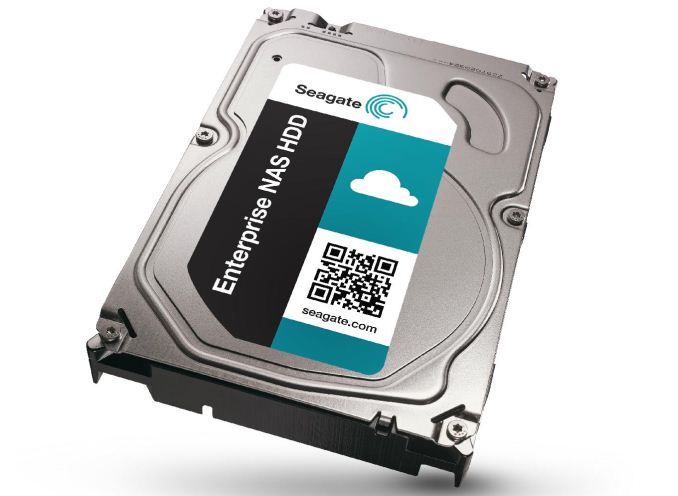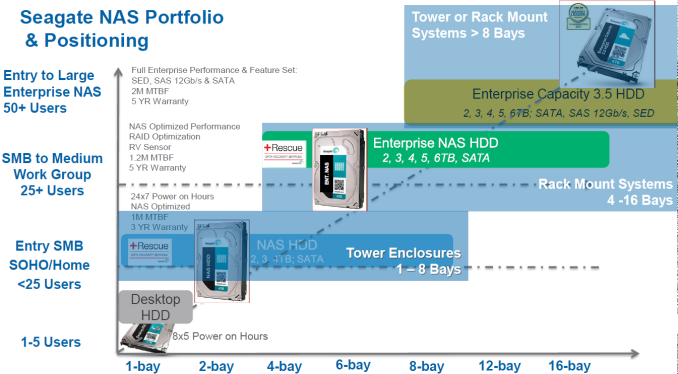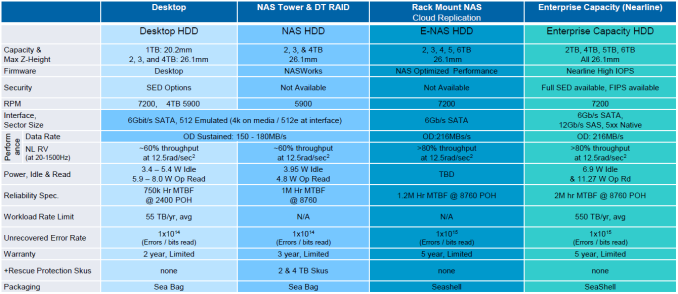Seagate Enterprise NAS HDD: WD Red Pro Gets a Competitor
by Ganesh T S on December 2, 2014 8:00 AM EST- Posted in
- NAS
- Storage
- Seagate
- HDDs
- Enterprise

We have seen this story play out before. Western Digital delineates the hard drive market with a product aimed at a particular niche and Seagate comes in a few months later with a new product line aiming to one-up Western Digital's introduction. The specifications for the Seagate product are a little bit better (SKUs with higher capacity, slightly better performance etc.) - after all, it never pays to be a me-too product in the market without offering something extra to the end users. In the same vein, Seagate is introducing the Enterprise NAS HDD today to go against Western Digital's Red Pro
Similar to the WD Red Pro, the Enterprise NAS HDD is targeted at prosumers / SMB / SME tower and rackmount form factor systems with 8-16 bays (though nothing prevents them from being used in systems with a lower bay count). They are standard 7200 RPM drives with the right balance of features imported from both the NAS HDD as well as Enterprise Capacity lineups.
The key points of differentiation over the WD Red Pro are listed below:
- Higher maximum capacity (6 TB for the Enterprise NAS HDD vs. 4 TB for the Red Pro)
- Larger cache size (128 MB in the Enterprise NAS HDD vs. 64 MB in the WD Red Pro)
- Slightly better MTBF ratings (1.2M for the Enterprise NAS HDD vs. 1M for the Red Pro)
- Bundled data recovery service (not available for WD Red Pro)
Other aspects (such as warranty and URE ratings) are mostly similar. Out of the four points above, the bundled data recovery service is the most interesting. Seagate introduced their data rescue and hardware replacement services last year. In pursuit of differentiation and better integration of this offering with the rest of the company products, the Enterprise NAS HDDs come with this service bundled in the cost. In case of any failure (environmental, accidental or even human error), Seagate handles data recovery as well as replacement of faulty drives (within the warranty limitations). Failed RAID arrays are no exception. With the Enterprise NAS HDDs, this DRS is valid for 3 years starting with the date of purchase. Since the risk of data loss and recovery is borne by Seagate for a reasonable premium, both end-users and resellers are bound to be happy.
Coming back to the rest of the HDD products from Seagate, the table below compares their specifications and differentiating aspects.
Even though it is not specifically mentioned, Seagate indicated that the Enterprise NAS HDDs are designed for workloads up to 180 TB/yr.
For the launch of the Enterprise NAS HDDs, Seagate has teamed up with QNAP. They are also running two webinars to cover any questions that SMB / SME IT decision makers may have regarding the new products.
Pricing information is not available yet, but Seagate indicated that they would be competitive with the WD Red Pro at similar capacity points (with a reasonable premium for the additional data recovery service).
Source: Seagate












22 Comments
View All Comments
Gigaplex - Tuesday, December 2, 2014 - link
If you're buying large quantities of drives to put in arrays, you really shouldn't be needing 3rd party data recovery services for individual drives. If a drive fails, you simply yank it and rebuild the array, and if the array goes down, you recover from backup.If you're not using arrays with backups, why are you buying an enterprise NAS drive in the first place?
buternutz - Saturday, December 6, 2014 - link
^^^The most accurate comment in this thread^^MrSpadge - Tuesday, December 2, 2014 - link
To be fair, Backblaze is using regular desktop drives in environments they were not designed for: high vibration from 40+ drives in a pod. The results of that study are surely valid if you use the drives in such an environment.. but they don't necessarily apply to other environments.Think about it: if Seagate drives were really failing at these rates in the wild, HGST and WD would already have taken over the market. And they put the RV (rotational vibration) sensors in the modles for more drive bays for a good reason.
Concillian - Tuesday, December 2, 2014 - link
The backblaze data also mentioned Seagate AND WD 5400 RPM drives that routinely failed nearly instantly. There's a lot of evidence that supports their environment is not suited towards certain drives. I don't think the average consumer should put much, if any, weight on those results. If it was routine for Seagate to have return rates at a multiple of competitors in normal application, then they'd be in big trouble selling to people like Dell, HP, etc...Samus - Wednesday, December 3, 2014 - link
I actually haven't seen a modern crashed hard disk in awhile. I think the last drive I came across that actually failed from a head crash was a WD Blue 500GB OEM in an HP, sometime in 2013.Laptop drives are another story. I come across near-dead 2.5" drives monthly. I take the opportunity to always replace it with an SSD. It'd be borderline unethical to do otherwise.
bigboxes - Wednesday, December 3, 2014 - link
All drives fail. All manufacturers go through bad batches. I recently had to throw away a 2TB WD drive that was out of warranty. I've had Hitachi drives go bad. Seagate, Samsung and Maxtor too. But I learned long ago to back up my data. I'm working on a second set of backups, but that is expensive. I am 2/3rd of the way there. All about money for me and my expensive hobby.ivan256 - Tuesday, December 2, 2014 - link
So they're trying to get a few more bucks out of the SMB market without eating into their nearline margins...This is purely a marketing launch.
MrSpadge - Tuesday, December 2, 2014 - link
These drives are clearly different from the regular NAS versions. There's the higher spindle speed, higher rated durability, vibration compensation and longer warrenty. The "Enterprise capacity" has this as well, but also some more features which someone may not need. If the "Enterprise NAS" is cheaper than "Enterprise capacity" this is clearly more than marketing.SunLord - Tuesday, December 2, 2014 - link
Nearline supports SAS and has hardware support for full disk self encryptionSamus - Wednesday, December 3, 2014 - link
The firmware alone could make these drives infinitely more reliable in certain scenario's desktop firmware wasn't engineered for. Even if its the same drive mechanically (which it isn't) they can still legitimately sell it as a superior product for a different application. Look at WD's Purple/Red drives, which are basically Green's with tweaked firmware and added sensors, or the Red Pro, which are basically Black drives with modified "RE" firmware.